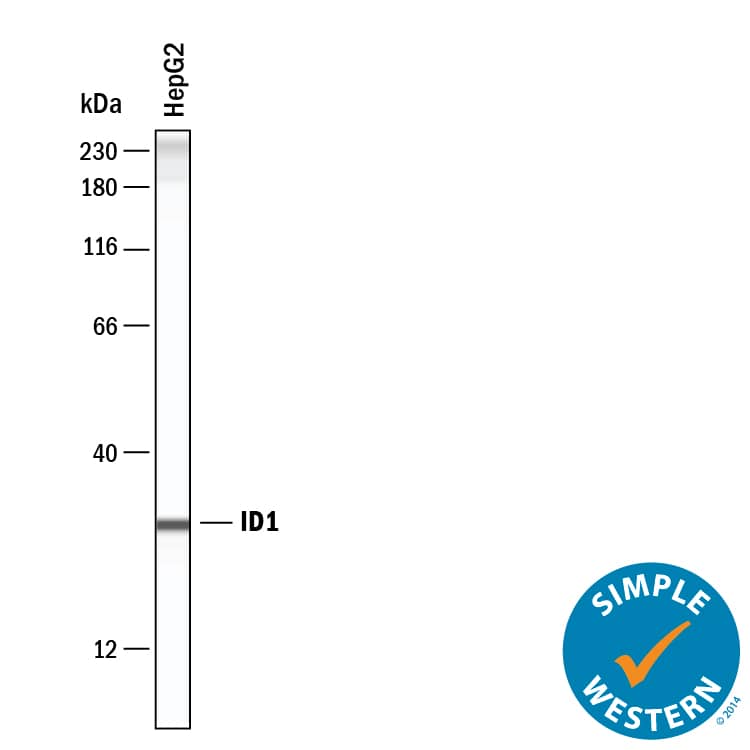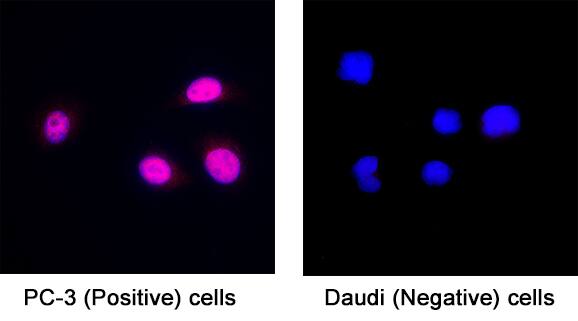Human/Mouse ID1 Antibody
R&D Systems, part of Bio-Techne | Catalog # AF4377

Key Product Details
Species Reactivity
Validated:
Human, Mouse
Cited:
Human
Applications
Validated:
Immunocytochemistry, Simple Western, Western Blot
Cited:
Western Blot
Label
Unconjugated
Antibody Source
Polyclonal Goat IgG
Product Specifications
Immunogen
E. coli-derived recombinant mouse ID1
Met1-Glu135
Accession # P20067
Met1-Glu135
Accession # P20067
Specificity
Detects human and mouse ID1 in Western blots.
Clonality
Polyclonal
Host
Goat
Isotype
IgG
Scientific Data Images for Human/Mouse ID1 Antibody
Detection of Human ID1 by Western Blot.
Western blot shows lysates of HepG2 human hepatocellular carcinoma cell line and MCF-7 human breast cancer cell line. Gels were loaded with 20 µg of cytoplasmic (Cyto) and 10 µg of nuclear extracts (Nuc). PVDF membrane was probed with 1 µg/mL Goat Anti-Human/Mouse ID1 Antigen Affinity-purified Polyclonal Antibody (Catalog # AF4377) followed by HRP-conjugated Anti-Goat IgG Secondary Antibody (HAF017). A specific band for ID1 was detected at approximately 25 kDa (as indicated). This experiment was conducted under reducing conditions and using Immunoblot Buffer Group 1.ID1 in BG01V Human Embryonic Stem Cells.
ID1 was detected in immersion fixed BG01V human embryonic stem cells, undifferentiated (lower panel) and differentiated into neural progenitor cells (upper panel), using Goat Anti-Human/Mouse ID1 Antigen Affinity-purified Polyclonal Antibody (Catalog # AF4377) at 10 µg/mL for 3 hours at room temperature. Cells were stained using the NorthernLights™ 557-conjugated Anti-Goat IgG Secondary Antibody (red; NL001) and counterstained with DAPI (blue). Specific staining was localized to nuclei. View our protocol for Fluorescent ICC Staining of Cells on Coverslips.Detection of Human ID1 by Simple WesternTM.
Simple Western lane view shows lysates of HepG2 human hepatocellular carcinoma cell line, loaded at 0.2 mg/mL. A specific band was detected for ID1 at approximately 30 kDa (as indicated) using 20 µg/mL of Goat Anti-Human/Mouse ID1 Antigen Affinity-purified Polyclonal Antibody (Catalog # AF4377) . This experiment was conducted under reducing conditions and using the 12-230 kDa separation system.Applications for Human/Mouse ID1 Antibody
Application
Recommended Usage
Immunocytochemistry
5-15 µg/mL
Sample: Immersion fixed BG01V human embryonic stem cells differentiated to neural progenitor cells, PC-3 human prostate cancer cells (Positive) & absent in Daudi human Burkitt's lymphoma cells (Negative)
Sample: Immersion fixed BG01V human embryonic stem cells differentiated to neural progenitor cells, PC-3 human prostate cancer cells (Positive) & absent in Daudi human Burkitt's lymphoma cells (Negative)
Simple Western
20 µg/mL
Sample: HepG2 human hepatocellular carcinoma cell line
Sample: HepG2 human hepatocellular carcinoma cell line
Western Blot
1 µg/mL
Sample: HepG2 human hepatocellular carcinoma cell line and MCF-7 human breast cancer cell line
Sample: HepG2 human hepatocellular carcinoma cell line and MCF-7 human breast cancer cell line
Formulation, Preparation, and Storage
Purification
Antigen Affinity-purified
Reconstitution
Reconstitute at 0.2 mg/mL in sterile PBS. For liquid material, refer to CoA for concentration.
Formulation
Lyophilized from a 0.2 μm filtered solution in PBS with Trehalose. *Small pack size (SP) is supplied either lyophilized or as a 0.2 µm filtered solution in PBS.
Shipping
Lyophilized product is shipped at ambient temperature. Liquid small pack size (-SP) is shipped with polar packs. Upon receipt, store immediately at the temperature recommended below.
Stability & Storage
Use a manual defrost freezer and avoid repeated freeze-thaw cycles.
- 12 months from date of receipt, -20 to -70 °C as supplied.
- 1 month, 2 to 8 °C under sterile conditions after reconstitution.
- 6 months, -20 to -70 °C under sterile conditions after reconstitution.
Background: ID1
ID-1a is a negative regulator of helix-loop-helix (HLH) DNA binding proteins. ID-1a contains a HLH motif but no DNA binding motif, therefore, upon binding other HLH proteins, ID-1a acts a dominant negative regulator. ID-1a can be found in both cytoplasmic and nuclear cell fractions. Increased ID-1a expression is associated with cellular proliferation and cancer.
Long Name
Inhibitor of DNA Binding 1
Alternate Names
BHLHB24, bHLHb24DNA-binding protein inhibitor ID-1, Class B basic helix-loop-helix protein 24, dJ857M17.1.2, dJ857M17.1.2 (inhibitor of DNA binding 1, dominant negative helix-loop-helixprotein), ID, inhibitor of differentiation 1, Inhibitor of DNA binding 1, inhibitor of DNA binding 1, dominant negative helix-loop-helix protein
Gene Symbol
ID1
UniProt
Additional ID1 Products
Product Documents for Human/Mouse ID1 Antibody
Product Specific Notices for Human/Mouse ID1 Antibody
For research use only
